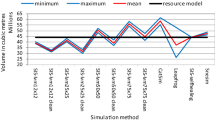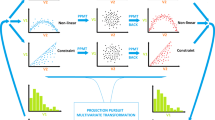Abstract
Localised Multivariate Uniform Conditioning (LMUC) is a technique designed for spatially locating Selective Mining Unit (SMU) grades derived using Multivariate Uniform Conditioning (MUC) for the assessment of recoverable resources. LMUC has the advantage of producing SMU estimates conforming to the MUC panel-specific grade-tonnage curves while preserving the spatial grade distribution at the selective mining level. However, LMUC results have two severe artifacts. This paper documents both artifacts using four grades from a large nickel–cobalt laterite deposit in Western Australia.
You have full access to this open access chapter, Download conference paper PDF
Similar content being viewed by others
Keywords
1 Introduction
Uniform Conditioning (UC) uses a set of predetermined cut-offs to estimate the grade, metal and tonnage of SMUs inside a panel using the estimated panel grade [1, 2]. These estimates are often not practical for many mining studies because of the limited capacity for visualising the likely spatial grade distribution at the SMU scale. Post-processing using localised uniform conditioning (LUC) allows to localise the SMU grades in such a way that SMU blocks have grade-tonnage relationships matching the UC results [3]. This is useful, for instance, for open pit mining studies that require evaluating the economics of a project.
Deraisme et al. [4] extended the concept of LUC to the multivariate case. The key idea is to analogously use the panel-specific recovery curves derived from MUC [5] to localise the results. The process is straightforward and has practical merits. However, it produces two artifacts that suggest the multivariate localisation is flawed. The first one corresponds to unrealistic linear-like patterns in the scatterplots between localised attributes. This artifact can be partially detected in Fig. 7 of [4] and it is clearly seen in Fig. 8 of [6]. The second artifact relates to the discrepancy between the expected theoretical correlation at the SMU support derived from MUC and the corresponding one between localised attributes. In this article, both artifacts are discussed using data from a large nickel–cobalt laterite deposit in Western Australia as a case study.
The article is organised as follows: firstly, a summary of MUC and LMUC are presented where the concepts and notations used are introduced. Secondly, a summary of the nickel–cobalt laterite deposit characteristics along with details of the LMUC application are presented. Thirdly, the case study results are discussed. Lastly, conclusions and recommendations are drawn on the bases of the findings.
2 Multivariate Uniform Conditioning and LMUC
MUC represents a most challenging problem in Geostatistics. For a set of multivariate attributes \(\left({Z}_{1},{Z}_{2}, \ldots, {Z}_{N}\right)\) the problem consists in estimating recoverable resources inside a mining panel \(V\) using the set of multivariate estimated panel grades \(\left({Z}_{1}^{*}\left(V\right), {Z}_{2}^{*}\left(V\right), \ldots , {Z}_{N}^{*}\left(V\right)\right)\) where each estimate is assumed to be conditionally unbiased.
The MUC model proposed by Deraisme et al. [5] proceeds first by independently applying the discrete Gaussian method [2] to each attribute \({Z}_{i}\), \(i=1,\ldots ,N\) which allows expressing the grades \({Z}_{i}\left(x\right)\) at point support, \({Z}_{i}\left(v\right)\) at SMU support, and the estimated grades \({Z}_{i}^{*}\left(V\right)\) at panel support as functions of standard Gaussian variables \({Y}_{i}\left(x\right)\), \({Y}_{iv}\) and \({Y}_{iV}^{*}\) respectively given by
and
where \({H}_{n}\) are the Hermite polynomials and \({\phi }_{in}\) are the corresponding coefficients with \({r}_{i}\) and \({s}_{i}\) the variance correction factors for SMU and panel support respectively. Here, the same number of Hermite polynomials is being used for all attributes. This is just a minor restriction required for computation of theoretical values during MUC such as the covariance between the SMU support grades in Eq. 6. The MUC model is entirely specified once the variance correction factors \({r}_{i}\) and \({s}_{i}\) and the correlations between the equivalent Gaussian variables are calculated. The former is obtained by inverting Eqs. 4 and 5
while the latter at the SMU support \(v\) by inverting Eq. 6
where \({\rho }_{ij}\) corresponds to the correlation between \({Y}_{iv}\) and \({Y}_{jv}\). This implies that the \(Corr\left({Z}_{i}\left(v\right),{Z}_{j}\left(v\right)\right)\) between any two different attributes \({Z}_{i}\) and \({Z}_{j}\) at the SMU \(v\) support can be explicitly computed using Eqs. 4 and 6. Through a set of conditional independence assumptions and the use of a master or anchor attribute for identifying whether or not a given SMU is above a cut-off, the MUC model effectively reduces the multivariate case to a bivariate one and the values of the remaining parameters required to completely specify the model can be calculated. Selection of the master attribute is of prime importance because the MUC model is driven by the correlations between the master and all other attributes while other correlations can, at most, be partly inferred through their corresponding relations with the main attribute. The reader is referred to Deraisme et al. [5] for further details.
Deraisme et al. [4] extended the concept of LUC to the multivariate case. Using the panel-specific tonnage curve of the master attribute along with the panel-specific metal curves of all attributes derived from MUC, the corresponding grades can be localised as done in LUC. The ranking is though entirely based on the direct estimate of the master attribute at the SMU support.
3 Case Study Presentation and Results
The data used for the case study comes from the Murrin Murrin East (MME) nickel–cobalt laterite deposit in Western Australia. The main mineralised body is approximately 1,500 m long, 600 m wide, and 30 m thick (Fig. 1). Surficial chemical weathering of ultramafic rocks resulted in the formation of nickel–cobalt laterites. Mineralisation occur as laterally extensive and undulating blankets with strong vertical zonation [7]. The attributes of interest include Co(%), Fe(%), Mg(%), and Ni(%) which was used as the master attribute. In total, 20,690 samples of 1 m length from 926 RC holes comprise the database for this study. The RC holes are approximately located on a square grid of 25 m × 25 m. The panel and SMU dimensions are 25 m × 25 m × 2 m and 5 m × 5 m × 1 m respectively. Consequently, each panel contains 50 SMUs (Fig. 1). Descriptive statistics and correlations between attributes are shown in Table 1.
3.1 Global and Local Scatterplots
Figure 2 shows the global scatterplot between localised Ni and Co grades along with the same scatterplot for SMUs inside five different panels selected randomly across the deposit. Globally, the localised grades at the SMU support seem to reproduce the input correlation between Ni and Co. However, locally, i.e., for SMUs in a panel, the results are drastically different. The correlation of 0.583 between Ni and Co becomes almost perfect for SMUs inside the five panels with clear linear-like patterns. This artifact is a direct consequence of using a master attribute to localise the SMU grades as it will be shown next.
3.2 Correlation Between Localised Attributes
The multivariate localisation imposes relationships between attributes that do not necessarily guarantee the reproduction of the global expected theoretical correlations \(Corr\left({Z}_{i}\left(v\right),{Z}_{j}\left(v\right)\right)\) given by the MUC model.
Without loss of generality, let \({Z}_{1}\) be the master attribute and \(\left({Z}_{1},{Z}_{2}, \ldots ,{Z}_{N}\right)\) the localised attributes inside a panel \(V\). The average grade \({M}_{i}\) for \({Z}_{i}\) is the ratio of the amount of metal \({Q}_{i}\) and tonnage \({T}_{1}\) for \(i=\mathrm{1,2},\ldots ,N\). Therefore, the average grades \({M}_{i} i\ge 2\) are related to \({M}_{1}\) by Eq. (7)
Equation (7) implies that when the master attribute \({Z}_{1}\) falls within a grade class \([a,b)\) during the localisation, the secondary attribute \({Z}_{i}\) is calculated as
where \({Q}_{i}\left(a\right)\) and \({Q}_{i}\left(b\right)\) are the panel-specific metal curves for attribute \({Z}_{i}\) evaluated at \(a\) and \(b\) respectively \(.\) This shows why after the localisation, the scatterplots between the master and all other localised attributes exhibit linear-like patterns. Equation (8) also shows that localised secondary attributes are implicitly related by
A comparison of the expected theoretical and localised attributes correlations is provided in Table 2.
Moreover, localised secondary attributes may have spurious results. For instance, although Fe and Mg have negative correlation, the scatterplot between the corresponding localised grades inside a panel exhibit positive correlations (Fig. 3).
Scatterplot between input Fe and Mg grades (top) and corresponding localised grades (bottom). Coloured lines are the scatterplot between corresponding localised grades for SMUs inside the same panels used in Fig. 2
4 Conclusions
The current implementation of MUC reduces a multivariate problem to a bivariate one through the nomination of a master or anchor attribute for identifying SMUs that are above a cut-off of interest. Although this seems reasonable for MUC applications, localising the MUC results produces two severe artifacts. These are a direct consequence of using the master attribute along with the MUC results to guide the localisation.
LMUC results exhibit linear-like patterns not consistent with the characteristics of the input data. Those correspond to the scatterplots of localised attributes within a panel. The consequence of this is that the correlation between localised attributes is drastically different at the global, i.e., across the mineralised domain under study, and local scale, i.e., inside a mining panel.
References
Chilès, J.-P., Delfiner, P.: Geostatistics: Modeling Spatial Uncertainty, 2nd edn. Wiley, New York (2012)
Rivoirard, J.: Introduction to Disjunctive Kriging and Non-linear Geostatistics. Oxford Press, Claredon (1994)
Abzalov, M.Z.: Localised uniform conditioning (LUC): A new approach for direct modelling of small blocks. Math. Geol. 38, 393–411 (2006)
Deraisme, J., Assibey-Bonsu, W., Baafi, E.Y., et al.: Localised uniform conditioning in the multivariate case-an application to a porphyry copper gold deposit. In: Proceedings of the 35th APCOM Conference (2011)
Deraisme, J., Rivoirard, J., Carrasco, P.: Multivariate uniform conditioning and block simulations with discrete gaussian model: application to chuquicamata deposit. In: VIII International Geostatistics Congress, GEOSTATS, pp. 69–78 (2008)
Deraisme, J., Assibey, W.: Comparative study of localized block simulations and localized uniform conditioning in the multivariate case. In: Abrahamsen, P., Hauge, R., Kolbjørnsen, O. (eds.) Geostatistics Oslo 2012, pp. 309–320. Springer, Netherlands Dordrecht (2012)
Murphy, M.: Geostatistical Optimisation of Sampling and Estimation in a Nickel Laterite Deposit. Edith Cowan University (unpublished) (2003)
Acknowledgements
The authors would like to thank Professor Ute Mueller for her help improving the manuscript. The second author acknowledges the funding and support from CSIRO’s Deep Earth Imaging Future Science Platform.
Author information
Authors and Affiliations
Corresponding author
Editor information
Editors and Affiliations
Rights and permissions
Open Access This chapter is licensed under the terms of the Creative Commons Attribution 4.0 International License (http://creativecommons.org/licenses/by/4.0/), which permits use, sharing, adaptation, distribution and reproduction in any medium or format, as long as you give appropriate credit to the original author(s) and the source, provide a link to the Creative Commons license and indicate if changes were made.
The images or other third party material in this chapter are included in the chapter's Creative Commons license, unless indicated otherwise in a credit line to the material. If material is not included in the chapter's Creative Commons license and your intended use is not permitted by statutory regulation or exceeds the permitted use, you will need to obtain permission directly from the copyright holder.
Copyright information
© 2023 The Author(s)
About this paper
Cite this paper
Rondon, O., Talebi, H. (2023). Artifacts in Localised Multivariate Uniform Conditioning: A Case Study. In: Avalos Sotomayor, S.A., Ortiz, J.M., Srivastava, R.M. (eds) Geostatistics Toronto 2021. GEOSTATS 2021. Springer Proceedings in Earth and Environmental Sciences. Springer, Cham. https://doi.org/10.1007/978-3-031-19845-8_12
Download citation
DOI: https://doi.org/10.1007/978-3-031-19845-8_12
Published:
Publisher Name: Springer, Cham
Print ISBN: 978-3-031-19844-1
Online ISBN: 978-3-031-19845-8
eBook Packages: Earth and Environmental ScienceEarth and Environmental Science (R0)







